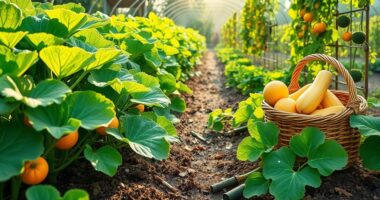When I explored greywater systems for greenhouses, two stood out as my top picks: simple diversion systems and more advanced constructed wetlands. The diversion systems are easy to install and maintain, perfect for beginners. On the other hand, constructed wetlands provide excellent filtration, promoting healthier plants. Both options greatly reduce water usage and enhance sustainability. If you're curious about how these systems can work for you, I'll share more details on their benefits and setup.
Key Takeaways
- Simple greywater systems are ideal for beginners, requiring less installation effort while efficiently irrigating greenhouse plants.
- Laundry water systems provide nutrient-rich water, beneficial for leafy greens, enhancing growth and sustainability.
- Kitchen greywater systems can be tailored for fruiting plants, offering potassium-rich solutions for improved yields.
- Regular testing and monitoring of greywater quality ensure plants receive balanced nutrients and prevent salinization.
- Proper maintenance, including filter cleaning and leak inspections, is crucial for the longevity and efficiency of greywater systems.
Create an Oasis with Greywater 6th Ed: Integrated Design for Water Conservation

If you're a home builder or passionate gardener looking to make your backyard more sustainable, "Create an Oasis with Greywater 6th Ed: Integrated Design for Water Conservation" is the perfect guide for you. This book thoroughly explains greywater systems and their installation, making it practical for anyone interested in water conservation. I found the worksheets particularly helpful for planning my setup. The high-quality illustrations made visualizing the process easy. Readers rave about its informative content, and I couldn't agree more—it's a fantastic resource for creating greener gardens. Just keep in mind the limited info for colder climates when planning your system!
Best For: Home builders and passionate gardeners looking to implement sustainable greywater systems in their backyards.
Pros:
- Thorough explanations and practical worksheets make the installation of greywater systems easy to understand and implement.
- High-quality illustrations and photographs aid visual learners in grasping the concepts and processes involved.
- Positive reader feedback highlights the book as an excellent resource for creating greener gardens and enhancing home sustainability.
Cons:
- Limited information for colder climates may leave readers in freezing regions seeking additional guidance on greywater systems.
- Complex categorization of systems could overwhelm beginners or those looking for straightforward solutions.
- May not cater to more inventive or technical readers, who might find the content lacking in advanced details.
Year Round Solar Greenhouse & Off Grid Solar Power Guide

For anyone enthusiastic to embrace sustainable living, the "Year Round Solar Greenhouse & Off Grid Solar Power Guide" stands out as an invaluable resource. It simplifies the complexities of building a solar-powered greenhouse, making it accessible even for beginners. The book meticulously guides you from planning to maintenance, helping you avoid common pitfalls. It also dives into off-grid solar options, perfect for those wanting self-sufficiency. I found the clear instructions empowering, providing essential knowledge to work confidently with contractors. With practical insights and a well-organized structure, it's an essential tool for anyone looking to cultivate a sustainable garden year-round.
Best For: Individuals interested in sustainable living and those looking to build a solar-powered greenhouse while gaining knowledge about off-grid solar systems.
Pros:
- Provides clear and accessible guidance for beginners in building solar-powered greenhouses.
- Covers a comprehensive range of topics, including planning, construction, and maintenance, as well as off-grid solar options.
- Empowers readers with practical knowledge to effectively communicate with contractors and manage their own projects.
Cons:
- Minor editing issues may detract from the overall readability for some readers.
- Could benefit from additional illustrations to enhance clarity and understanding of complex concepts.
- Primarily targeted at a specific audience, which may limit its appeal to those outside the realm of homesteading or solar energy enthusiasts.
Factors to Consider When Choosing Greywater Systems in Greenhouses

When choosing a greywater system for my greenhouse, I consider several key factors. The type of system, the quality of the water source, and how well it adapts to my climate are all essential. I also think about maintenance needs and how complex the installation will be to guarantee everything runs smoothly.
System Type Selection
Choosing the right greywater system for your greenhouse involves several key factors that can considerably impact both efficiency and ease of use. First, consider the type of greywater source you have—whether it's from a sink, shower, or laundry—as each has different nutrient levels and contaminants. I also recommend evaluating the system's complexity; simpler systems are often better for beginners. Don't forget to factor in your local climate, especially if you live in freezing areas, where you'll need to guard against freezing. The greenhouse's layout and size are essential too; the system should integrate seamlessly without disrupting your workflow. Finally, think about water recycling efficiency; some systems can drastically cut down on your overall water usage.
Water Source Quality
The quality of your greywater source plays a significant role in the overall effectiveness of your greenhouse irrigation system. Greywater, generated from sinks, showers, and laundry, can vary widely based on the soaps and detergents used. It's vital to guarantee your greywater is free from harmful chemicals and pathogens, as these can harm plant health and soil quality. Additionally, high levels of salts or nutrients can lead to soil salinization, negatively affecting plant growth over time. To mitigate risks, proper filtering and treatment of greywater is important. I also recommend regular testing to monitor its quality and adjust treatment methods as needed, guaranteeing ideal conditions for your plants to thrive in the greenhouse.
Climate Adaptability
Understanding how climate impacts greywater systems is essential for ensuring your greenhouse operates efficiently year-round. Each region presents unique challenges, especially in colder climates where freezing temperatures can threaten plumbing and water delivery. I've found that insulating pipes and using drain fields that prevent freezing are vital for winter functionality. It's clear that limited information exists on greywater systems in these frigid areas, so tailored approaches become necessary. Additionally, I consider seasonal variations in water availability and plant needs when designing my system, as these factors optimize irrigation throughout the year. By grasping how local climate influences plant growth and water conservation, I can select the most suitable greywater system for my greenhouse.
Maintenance Requirements
When it comes to greywater systems in my greenhouse, regular maintenance is vital for keeping everything running smoothly. I clean filters and check pumps monthly to prevent clogs and guarantee proper filtration. It's also important to inspect the system for leaks and wear at least twice a year to maintain efficiency and avoid wasting water. I monitor my plants for any nutrient imbalances or salt buildup, which can happen if greywater isn't managed correctly. Scheduled maintenance includes testing the pH and salinity levels to guarantee the greywater remains suitable for plant health. I keep proper documentation of all maintenance activities, which helps me identify patterns and proactively address any issues with the greywater system.
Installation Complexity
Regular maintenance keeps my greywater system functioning well, but installation complexity is another key factor to contemplate. The design and intended use of the system can greatly influence how complicated the installation is. Simpler systems require less plumbing and fewer modifications, making them easier to set up. I've learned that understanding local building codes is vital; compliance can add to the complexity. If I'm retrofitting an existing greenhouse, I need to assess my plumbing layout, as it might demand extensive changes. Professional help can simplify the installation process, while a lack of resources can complicate DIY efforts. Finally, considering climate factors, like freezing temperatures, is essential, as they may necessitate extra insulation measures.
Plant Nutrient Needs
Choosing the right greywater system for my greenhouse hinges on the specific nutrient needs of the plants I'm growing. Different plants have varying requirements; for instance, leafy greens thrive on nitrogen-rich greywater, while fruiting plants benefit from higher potassium levels. Since the nutrient concentration in greywater can fluctuate based on its source—like laundry or kitchen water—it's vital to assess what my plants need. A well-designed greywater system can help maintain a balanced nutrient supply, but I must be cautious to avoid over-fertilizing, which can harm both plants and soil. Regular testing of the greywater for nutrient levels allows me to optimize its use, ensuring my plants receive the essential nutrients for robust growth.
Frequently Asked Questions
Can Greywater Systems Be Installed in Existing Greenhouses?
Absolutely, I've found that greywater systems can be installed in existing greenhouses with some planning. It's crucial to assess your current setup, ensuring you have the right plumbing and drainage in place. I've successfully integrated a system that captures water from sinks and showers, which I then use to irrigate my plants. Just make sure to follow local regulations and choose non-toxic soaps to keep your greenhouse thriving and safe!
How Often Should Greywater Systems Be Maintained?
I've found that maintaining greywater systems is essential for their efficiency. I usually check mine every few months to clean filters and inspect pipes for clogs. If I notice any issues, I address them immediately to prevent bigger problems. Seasonal checks are also a good idea, especially before the heavy usage in summer. Regular maintenance keeps everything running smoothly and guarantees I'm using water sustainably in my garden. It's worth the effort!
What Types of Plants Can Safely Use Greywater?
Imagine a garden where every drop of water tells a story. When it comes to greywater, I've found that certain plants thrive on this recycled resource. Herbs like basil and mint, along with fruiting plants like tomatoes and peppers, can safely use greywater. They're like the wise storytellers of the garden, drawing nutrients from their surroundings while keeping the cycle of life flourishing. I always make certain the water's free from harmful chemicals, though!
Is Greywater Safe for Edible Crops?
I've often wondered if greywater's safe for edible crops. In my experience, it can be used, but with caution. I make sure to avoid any water containing harmful chemicals or pathogens. I primarily use greywater from rinsing vegetables or showering, but I always apply it to non-fruit parts of the plants. It's crucial to research the plants you're growing, as some are more tolerant than others. Always prioritize your health and safety!
How Much Water Can a Greywater System Recycle?
Imagine turning your home's gentle runoff into a lifeline for your garden. A greywater system can recycle anywhere from 30 to 50 gallons of water daily, depending on your household size and usage. I've found that this can greatly reduce my water bills while nurturing my plants. It's a win-win! Just remember to keep track of the water's source to make sure it's suitable for your garden's needs.
Conclusion
In this journey of nurturing our greenhouses, think of greywater systems as the gentle rain that breathes life into our gardens. By choosing the right solution, we tap into nature's wisdom, transforming what once was waste into nourishment. So, let's embrace these sustainable practices, cultivating not just plants but a thriving ecosystem. Together, we can weave a tapestry of green, where every drop counts and every choice leads us toward a more harmonious existence with the earth.









